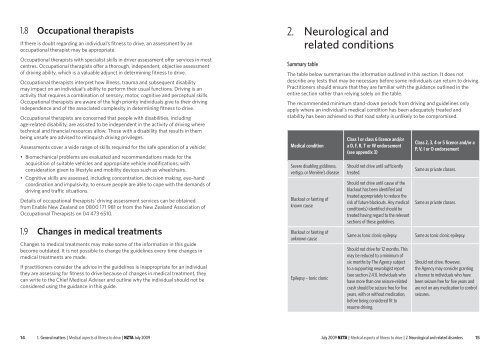Medical aspects of fitness to drive a guide for medical practitioners
Medical aspects of fitness to drive a guide for medical practitioners
Medical aspects of fitness to drive a guide for medical practitioners
Create successful ePaper yourself
Turn your PDF publications into a flip-book with our unique Google optimized e-Paper software.
1.8<br />
Occupational therapists<br />
If there is doubt regarding an individual’s <strong>fitness</strong> <strong>to</strong> <strong>drive</strong>, an assessment by an<br />
occupational therapist may be appropriate.<br />
Occupational therapists with specialist skills in <strong>drive</strong>r assessment <strong>of</strong>fer services in most<br />
centres. Occupational therapists <strong>of</strong>fer a thorough, independent, objective assessment<br />
<strong>of</strong> driving ability, which is a valuable adjunct in determining <strong>fitness</strong> <strong>to</strong> <strong>drive</strong>.<br />
Occupational therapists interpret how illness, trauma and subsequent disability<br />
may impact on an individual’s ability <strong>to</strong> per<strong>for</strong>m their usual functions. Driving is an<br />
activity that requires a combination <strong>of</strong> sensory, mo<strong>to</strong>r, cognitive and perceptual skills.<br />
Occupational therapists are aware <strong>of</strong> the high priority individuals give <strong>to</strong> their driving<br />
independence and <strong>of</strong> the associated complexity in determining <strong>fitness</strong> <strong>to</strong> <strong>drive</strong>.<br />
Occupational therapists are concerned that people with disabilities, including<br />
age‐related disability, are assisted <strong>to</strong> be independent in the activity <strong>of</strong> driving where<br />
technical and financial resources allow. Those with a disability that results in them<br />
being unsafe are advised <strong>to</strong> relinquish driving privileges.<br />
Assessments cover a wide range <strong>of</strong> skills required <strong>for</strong> the safe operation <strong>of</strong> a vehicle:<br />
• Biomechanical problems are evaluated and recommendations made <strong>for</strong> the<br />
acquisition <strong>of</strong> suitable vehicles and appropriate vehicle modifications, with<br />
consideration given <strong>to</strong> lifestyle and mobility devices such as wheelchairs.<br />
• Cognitive skills are assessed, including concentration, decision making, eye–hand<br />
coordination and impulsivity, <strong>to</strong> ensure people are able <strong>to</strong> cope with the demands <strong>of</strong><br />
driving and traffic situations.<br />
Details <strong>of</strong> occupational therapists’ driving assessment services can be obtained<br />
from Enable New Zealand on 0800 171 981 or from the New Zealand Association <strong>of</strong><br />
Occupational Therapists on 04 473 6510.<br />
1.9<br />
Changes in <strong>medical</strong> treatments<br />
Changes <strong>to</strong> <strong>medical</strong> treatments may make some <strong>of</strong> the in<strong>for</strong>mation in this <strong>guide</strong><br />
become outdated. It is not possible <strong>to</strong> change the <strong>guide</strong>lines every time changes in<br />
<strong>medical</strong> treatments are made.<br />
If <strong>practitioners</strong> consider the advice in the <strong>guide</strong>lines is inappropriate <strong>for</strong> an individual<br />
they are assessing <strong>for</strong> <strong>fitness</strong> <strong>to</strong> <strong>drive</strong> because <strong>of</strong> changes in <strong>medical</strong> treatment, they<br />
can write <strong>to</strong> the Chief <strong>Medical</strong> Adviser and outline why the individual should not be<br />
considered using the guidance in this <strong>guide</strong>.<br />
2.<br />
Summary table<br />
Neurological and<br />
related conditions<br />
The table below summarises the in<strong>for</strong>mation outlined in this section. It does not<br />
describe any tests that may be necessary be<strong>for</strong>e some individuals can return <strong>to</strong> driving.<br />
Practitioners should ensure that they are familiar with the guidance outlined in the<br />
entire section rather than relying solely on the table.<br />
The recommended minimum stand‐down periods from driving and <strong>guide</strong>lines only<br />
apply where an individual’s <strong>medical</strong> condition has been adequately treated and<br />
stability has been achieved so that road safety is unlikely <strong>to</strong> be compromised.<br />
<strong>Medical</strong> condition<br />
Severe disabling giddiness,<br />
vertigo, or Meniére’s disease<br />
Blackout or fainting <strong>of</strong><br />
known cause<br />
Blackout or fainting <strong>of</strong><br />
unknown cause<br />
Epilepsy – <strong>to</strong>nic clonic<br />
Class 1 or class 6 licence and/or<br />
a D, F, R, T or W endorsement<br />
(see appendix 3)<br />
Should not <strong>drive</strong> until sufficiently<br />
treated.<br />
Should not <strong>drive</strong> until cause <strong>of</strong> the<br />
blackout has been identified and<br />
treated appropriately <strong>to</strong> reduce the<br />
risk <strong>of</strong> future blackouts. Any <strong>medical</strong><br />
condition(s) identified should be<br />
treated having regard <strong>to</strong> the relevant<br />
sections <strong>of</strong> these <strong>guide</strong>lines.<br />
Same as <strong>to</strong>nic clonic epilepsy.<br />
Should not <strong>drive</strong> <strong>for</strong> 12 months. This<br />
may be reduced <strong>to</strong> a minimum <strong>of</strong><br />
six months by The Agency subject<br />
<strong>to</strong> a supporting neurologist report<br />
(see section 2.4.1). Individuals who<br />
have more than one seizure‐related<br />
crash should be seizure free <strong>for</strong> five<br />
years, with or without medication,<br />
be<strong>for</strong>e being considered fit <strong>to</strong><br />
resume driving.<br />
Class 2, 3, 4 or 5 licence and/or a<br />
P, V, I or O endorsement<br />
Same as private classes.<br />
Same as private classes.<br />
Same as <strong>to</strong>nic clonic epilepsy.<br />
Should not <strong>drive</strong>. However,<br />
the Agency may consider granting<br />
a licence <strong>to</strong> individuals who have<br />
been seizure free <strong>for</strong> five years and<br />
are not on any medication <strong>to</strong> control<br />
seizures.<br />
14 1. General matters | <strong>Medical</strong> <strong>aspects</strong> <strong>of</strong> <strong>fitness</strong> <strong>to</strong> <strong>drive</strong> | NZTA July 2009<br />
July 2009 NZTA | <strong>Medical</strong> <strong>aspects</strong> <strong>of</strong> <strong>fitness</strong> <strong>to</strong> <strong>drive</strong> | 2. Neurological and related disorders 15
















